The Internet is for Representation: Queer Heroes of Webcomics
There’s a hard fact of life that every shipper must face: besides a few glorious exceptions, our queer interpretations of characters in mainstream media are unlikely to ever become canon. For every Willow Rosenberg and Ianto Jones, there are hundreds of Jim Kirks and Dean Winchesters – characters who are often coded as queer and have significant same-sex relationships, but will never be allowed to come out of the subtextual closet. This is because the stakes get higher the bigger a franchise gets. More and more focus groups and head executives and ratings analysts sit between the writers and actual progress. Risks don’t get taken because, when you’re working with audiences that big (and with paychecks that big) you can’t take risks.
And as sad as it is, in the culture we live in, telling queer stories is a risk.
But what about when there are no stakes? What about when it’s just someone in front of their computer, telling a story, beholden to no one?
Webcomics, people. I’m telling you. Webcomics.
I’m sure there are tons of great characters and stories that I’ve omitted. This is not by design, but due to the fact that I can’t read every single webcomic on the Internet. Feel free to shout out to your favorites in the comments.
Also, this article contains spoilers for the webcomics mentioned within. Some are rather big ones. You’ve been warned.
PvP by Scott Kurtz
I’m kicking it off with PvP, because it’s about as close to “mainstream” as webcomics get. It’s the massively successful and ridiculously long-running story of the staff of a gaming magazine. And their pet troll. And a cat that tries to take over the world every Christmas. Don’t ask, okay?
No doubt it owes a lot of its appeal to its simple layout and reliable Monday-through-Friday update schedule – it feels a lot like a newspaper comic strip. But because of the relative freedom of the internet compared to syndication, PvP is able to explore longer-arcing stories and more varied characters than most funnies-page comics would dare.
Max starts out as an antagonist – a douchey, annoying rival from a competing magazine. But he undergoes metric tons of character development, and eventually joins the main characters at the titular magazine. Along the way, there’s an interesting little plot arc where the two main protagonists, Cole and Brent, suspect Max is gay. Suddenly, instead of despising him and making fun of him behind his back as they always have, they begin to compete for his attention. Whether this is a weird inversion of alpha-male dynamics in which they are trying to appear attractive to a gay man, or whether they are trying to avoid being seen as homophobic by securing a “gay best friend,” Max is having none of it.
It’s a refreshing variation on the expected homophobia, and it highlights the way that fetishizing gayness (while it’s better than outright hatred) is dehumanizing, annoying, and really not okay. Max’s sexual orientation is none of Cole and Brent’s business. And Max’s personhood is acknowledged by the narrative as he is allowed to come out at his own pace.

Girls With Slingshots by Danielle Corsetto
I may give PvP props for having a token gay character, but to be fair, Lynn Johnston did that with For Better or For Worse in 1993. We can do better. And Girls with Slingshots drops tokenism off a bridge and buries it with a twenty-one gun salute.
Let’s start with Thea. She’s the main character’s boss, then her roommate when they both lose their jobs. She’s smart and driven, but also supremely awkward and self-conscious. When she starts dating Angel, the local bartender, she tends to get nervous and drink until she pukes. When that fling doesn’t work out (for reasons other than the puking), Thea meets a roller derby girl named Mimi and falls head over heels in love.
 I love Thea and her whole romantic arc. It’s not “lesbian romance;” it’s romance about lesbians. The main conflicts are almost never about the characters’ sexualities. Instead, Thea’s relationship with Angel ends because Angel only saw it as casual sex while Thea thought they were committed, and she later has to deal with her insecurities about being older than her new girlfriend, Mimi. There’s awkwardness with meeting parents and friends. Turns out Thea and Mimi both have the same chronic STI.
I love Thea and her whole romantic arc. It’s not “lesbian romance;” it’s romance about lesbians. The main conflicts are almost never about the characters’ sexualities. Instead, Thea’s relationship with Angel ends because Angel only saw it as casual sex while Thea thought they were committed, and she later has to deal with her insecurities about being older than her new girlfriend, Mimi. There’s awkwardness with meeting parents and friends. Turns out Thea and Mimi both have the same chronic STI.
Did I mention the STIs?
Because there is actual discussion of lesbians contracting and sharing STIs, and how to prevent that.
Rarely have I seen a work of fiction do so much to educate its readership on safe sex. And lesbian safe sex at that! Most comics might throw in a line or two about condoms, but few will mention the phrase “dental dam.” Fewer still will manage to make the whole sequence funny.

Oh yeah, and not to mention…
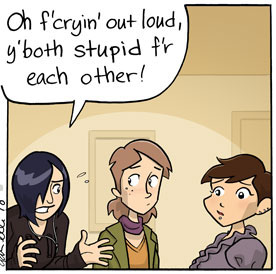
Jamie and Erin make up the other main queer couple of the comic. Jamie is a self-described “whatever-sexual.” Erin is a lesbian and, after some exploration, concludes that she is completely asexual. After their love stands the tests of insensitive friends, a miscommunication-driven breakup, and long distance, they settle on an open relationship that allows Jamie to get her needs met while they remain each other’s primary partner.
While their unusual arrangement causes confusion for others (and sometimes even themselves), their feelings for each other win the day. When Jamie gets frustrated trying to explain their relationship to her friends, and comes home to Erin despondently asking, “What are we?” Erin simply replies, “In love.”
And then there’s Darren. He’s a recurring guest star of the comic and a good friend to all the protagonists. He’s also a drag queen and a flaming homosexual in the spirit of Brian Kinney and Emmett Honeycutt’s theoretical unholy lovechild: promiscuous, flamboyant, and completely unapologetic. He very well might be a reductive stereotype, but if you said that to his face he’d probably take offense.
Questionable Content by Jeph Jacques
Questionable Content, while it’s always been a cute slice-of-life comic and it regularly passes the Bechdel Test, has been kind of mediocre in terms of queer representation for most of its run. Sure, Dora was bi and Tai would make occasional references to all the hot polyamorous lesbian sex she was having at college, but all the main couples were conspicuously straight.
That is, until Marten and Dora broke up (I told you there would be spoilers) and Dora finally hooked up with Tai. Their relationship is progressing nicely, and is tooth-rottingly adorable.
But more notably, Claire, a feisty redhead who works at the university with Marten and Tai, recently came out to Marten as trans*. No drama, no ongoing plotline. It’s just who she is.
Since then, other than a short conversation with Marten and a burst of protectiveness from her brother, Claire’s gender hasn’t come up. Jacques has continued to write her as a sweet, somewhat-awkward young woman with a temper. There have been some hints lately that a romance between Claire and Marten might be in the cards. I for one am looking forward to seeing Claire’s continued character development, and the progression of her relationships with the main characters.
Girly by Josh Lesnick
But as great as they are, none of the comics mentioned so far has featured a queer protagonist (not even Girls with Slingshots; you could argue that Jamie is a co-main-character, but the focus is undeniably on Hazel).
 Enter Girly: the extremely weird story of two girls and their adventures together. Girly is the sequel to Cutewendy, which relied more on dada humor and non sequitur, but also featured a lesbian duo as its protagonists. Girly is about the daughter of the couple from Cutewendy, and the lonely artist who she chooses to be her “sidekick.” Girly tones down the over-the-top ridiculousness of its parent comic, though it also indulges in absurdist humor (think elephants devouring a couch, forcing the protagonists to share a bed). It also draws heavily on anime and manga tropes in its early chapters, which sometimes clash with the more Western aesthetic. For instance, the hyperbolized violence that’s often played for laughs in anime comes across as borderline sociopathic in Girly. And a few of the early storylines are deeply problematic (Chupacabre, anyone?).
Enter Girly: the extremely weird story of two girls and their adventures together. Girly is the sequel to Cutewendy, which relied more on dada humor and non sequitur, but also featured a lesbian duo as its protagonists. Girly is about the daughter of the couple from Cutewendy, and the lonely artist who she chooses to be her “sidekick.” Girly tones down the over-the-top ridiculousness of its parent comic, though it also indulges in absurdist humor (think elephants devouring a couch, forcing the protagonists to share a bed). It also draws heavily on anime and manga tropes in its early chapters, which sometimes clash with the more Western aesthetic. For instance, the hyperbolized violence that’s often played for laughs in anime comes across as borderline sociopathic in Girly. And a few of the early storylines are deeply problematic (Chupacabre, anyone?).
But despite its flaws, Girly matures into a silly and deeply enjoyable comic that genuinely respects its characters and never plays its protagonists’ sexuality for laughs. And it ends with a few surprisingly serious arcs that wrap the story up quite nicely. It’s far from perfect, but it’s a kooky, cartoony adventure story starring lesbian lovers, and I’ll take it.
Friendly Hostility and Boy Meets Boy by K. Sandra Fuhr
 Boy Meets Boy, featuring Harley and his boyfriend Mikhael, may have been a fun little romp through self-aware man-on-man romance and fandom references. But its sequel comic, Friendly Hostility, was where K. Sandra Fuhr really hit her stride. The second comic focused on Fox and Collin, two childhood best friends who were guest stars in and hooked up at the end of Boy Meets Boy. The art was cleaner, the writing was more mature, and as much as I love Mikhael and Harley, Fox and Collin are simply better-realized characters.
Boy Meets Boy, featuring Harley and his boyfriend Mikhael, may have been a fun little romp through self-aware man-on-man romance and fandom references. But its sequel comic, Friendly Hostility, was where K. Sandra Fuhr really hit her stride. The second comic focused on Fox and Collin, two childhood best friends who were guest stars in and hooked up at the end of Boy Meets Boy. The art was cleaner, the writing was more mature, and as much as I love Mikhael and Harley, Fox and Collin are simply better-realized characters.
Friendly Hostility dealt with internalized homophobia, the evolution of sexual desire, multicultural relationships, the repercussions of parenting choices (both good and bad), the importance of found family, balancing work and a significant other, and the organic way that people grow together and eventually apart. And it does this all while taking itself seriously a bare, naked minimum of the time.
Besides Fox and Collin, special mention goes to Fox’s parents and their friend Rafi, the three of whom are almost certainly in a triad relationship of some shape or color. When Fox’s mother, Nefertari, is questioned about her husband’s close friendship with Rafi, she simply answers, “He’s ours.”
And more-than-special mention to Fatima Maharassa, Fox’s sister. She’s androgynous, violent, solitary, and her relationships consist of a woman who stalked her for a while and a man who she marries because, in her words, she “wants his house and his insufferable cat.” While she seems to genuinely like her husband, the true nature of their relationship remains ambiguous. A very strong case could be made for Fatima as asexual and aromantic. And did I mention that she’s a complete badass and my absolute favorite?

Subnormality by Winston Rowntree
And now for something completely different.
If you don’t mind slow, sporadic updates, giant walls of text, hard-to-follow layouts, and recurring characters who may go several months to years between recurrences, then I cannot recommend Subnormality enough. It’s not a webcomic; it’s philosophy is webcomic form. And while it doesn’t include queer stories or characters terribly often, it regularly demolishes the Bechdel Test.
I’m afraid that there’s simply no way to explain it properly. So I’m going to ask you to read this one, this one, and this one, and if you’re not convinced then there is no pleasing you.
And read this one too: the reason this comic made the list.
Gunnerkrigg Court by Tom Siddell
Needless to say, I recommend all the comics on this list at least to some extent. But Gunnerkrigg Court is the only one I’m going to have to get down on my knees and beg you to read. It’s about a group of kids at a boarding school that’s basically Hogwarts if the Harry Potter series had been based around magical realism instead of witchcraft, and the story is the kind of twisty-turny masterpiece that I couldn’t completely spoil even if I tried.
Take Zimmy for example. She’s a reality-warper, and the only way she can keep any measure of control over her powers is by staying close to a girl called Gamma. While their relationship is neither particularly healthy nor explicitly romantic, there is no doubt that they love each other deeply. Gamma stays awake to the point of collapse to keep from leaving Zimmy alone, and Zimmy’s combination of self-loathing and general misanthropy makes Gamma the only person in the world to whom she shows real affection.

Katerina (Kat) Donlan, the co-main character, is not an example of a queer heroine… yet. Many fans have seen the potential for a romantic relationship between Kat and her best friend Annie. So far, this one is only just moving its way out of subtext, and Kat’s discomfort with being mistaken for gay seems to lean toward her being straight. But it’s also been shown that that discomfort has more to do with other people’s perception of her than it does with her actual feelings for Annie. It remains to be seen whether this storyline will end with one of both of the girls coming out, but this comic is so consistently excellent that I trust the conclusion will make sense for the characters, whatever it is.
Robot and Shadow are a stranger case. They were the first two characters to be introduced, besides Annie, but since the first chapter they have remained mostly in the background. But even outside of the spotlight, their friendship continued to grow. Then, when an accident nearly destroys them both, the shock makes Robot come to the realization that he is in love with Shadow.

This is remarkable because, while other characters use he/him pronouns for Robot and Shadow by default, they are both fairly obviously agender. At least, you’d have a hard time making the case that either of them is male or female. The concept of agender, third gender, or bigender is ridiculously hard to find in fiction, and a romance between two such characters even more so. Yes, it kind of sucks that this representation had to come in the form of supernatural beings instead of human characters, but Robot and Shadow’s relationship continues to be portrayed as sweet and loving – never questioned or played for laughs. They’re pretty great.

The Less Than Epic Adventures of TJ and Amal by EK Weaver
Okay, I lied. I’m going to kneel and beg you to read this one, too.
This is a comic about a young man, Amal, who has recently been disowned by his family for being gay, and the drifter, TJ, he picks up to drive cross-country with. The art, the pacing, the writing, the characterization – everything is just spot-on. And if you read Weaver’s notes section or follow her on any social networking sites, you will soon gain an appreciation for the mind-boggling amount of work she’s put into this project.
(You should also follow EK Weaver on tumblr if only to see her answer stupid questions about who tops and who bottoms with unexplained 90s rap lyrics.)
TJ and Amal feel less like characters in a comic strip and more like real people who you happen to be watching through a short snapshot of their lives. There’s a sense of things happening within the comic, but just outside its scope. Of things that came before and things that will come after. There’s a very realistic sense of transience and melancholy, even though TJ’s antics will often have you clutching your sides.

And because the world and the people in it feel so real, you will root for these boys all the harder when they finally do hook up and fall in love. Even though you can kind of tell that it probably won’t end the way you’d like. Because hey, that’s life, isn’t it?
Author: Christina Kim
Help support independent journalism. Subscribe to our Patreon.
Copyright © The Geekiary
Do not copy our content in whole to other websites. If you are reading this anywhere besides TheGeekiary.com, it has been stolen.Read our









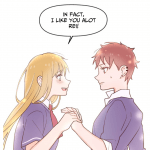
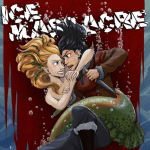

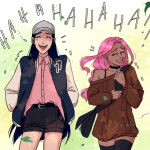
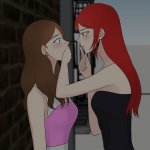
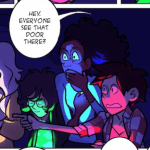
I would totally do something productive, but now I’m reading the adventures of TJ and Amal. Thank you very much =P
Mission accomplished!
Nice article!! I’m always interested in web comics AND queer couples in media so this is gr8. A fav couple of mine is Rose & Kanaya from Homestuck. I mean, the relationship between a human girl with an interest in psychotherapy/eldritch abominations and an alien-vampire-fashionista is pretty cool.
That does sound cool! And believe me, the only reason they aren’t on this list is because I haven’t quite girded my loins sufficiently to risk wading my way into Homestuck. 😉
Since this article was written, Claire and Marten started dating in Questionable Content and in Gunnerkrigg Court, Kat started dating a girl called Paz in an absolutely beautiful storyline that dealt with her coming out in a really good way. Just thought that was worth mentioning. 🙂